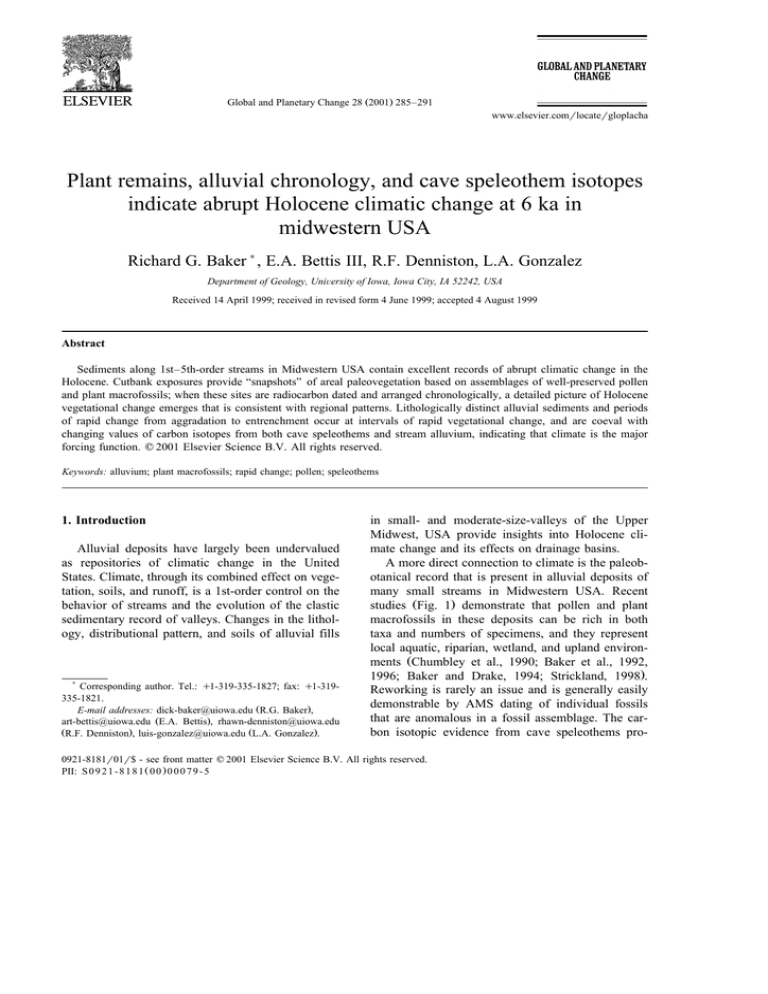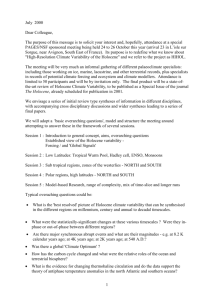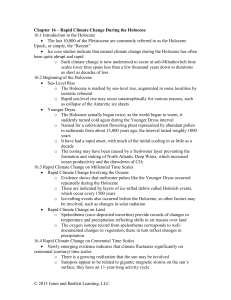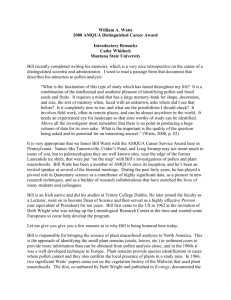Plant remains, alluvial chronology, and cave speleothem isotopes
advertisement

Global and Planetary Change 28 Ž2001. 285–291 www.elsevier.comrlocatergloplacha Plant remains, alluvial chronology, and cave speleothem isotopes indicate abrupt Holocene climatic change at 6 ka in midwestern USA Richard G. Baker ) , E.A. Bettis III, R.F. Denniston, L.A. Gonzalez Department of Geology, UniÕersity of Iowa, Iowa City, IA 52242, USA Received 14 April 1999; received in revised form 4 June 1999; accepted 4 August 1999 Abstract Sediments along 1st–5th-order streams in Midwestern USA contain excellent records of abrupt climatic change in the Holocene. Cutbank exposures provide AsnapshotsB of areal paleovegetation based on assemblages of well-preserved pollen and plant macrofossils; when these sites are radiocarbon dated and arranged chronologically, a detailed picture of Holocene vegetational change emerges that is consistent with regional patterns. Lithologically distinct alluvial sediments and periods of rapid change from aggradation to entrenchment occur at intervals of rapid vegetational change, and are coeval with changing values of carbon isotopes from both cave speleothems and stream alluvium, indicating that climate is the major forcing function. q 2001 Elsevier Science B.V. All rights reserved. Keywords: alluvium; plant macrofossils; rapid change; pollen; speleothems 1. Introduction Alluvial deposits have largely been undervalued as repositories of climatic change in the United States. Climate, through its combined effect on vegetation, soils, and runoff, is a 1st-order control on the behavior of streams and the evolution of the clastic sedimentary record of valleys. Changes in the lithology, distributional pattern, and soils of alluvial fills ) Corresponding author. Tel.: q1-319-335-1827; fax: q1-319335-1821. E-mail addresses: dick-baker@uiowa.edu ŽR.G. Baker., art-bettis@uiowa.edu ŽE.A. Bettis., rhawn-denniston@uiowa.edu ŽR.F. Denniston., luis-gonzalez@uiowa.edu ŽL.A. Gonzalez.. in small- and moderate-size-valleys of the Upper Midwest, USA provide insights into Holocene climate change and its effects on drainage basins. A more direct connection to climate is the paleobotanical record that is present in alluvial deposits of many small streams in Midwestern USA. Recent studies ŽFig. 1. demonstrate that pollen and plant macrofossils in these deposits can be rich in both taxa and numbers of specimens, and they represent local aquatic, riparian, wetland, and upland environments ŽChumbley et al., 1990; Baker et al., 1992, 1996; Baker and Drake, 1994; Strickland, 1998.. Reworking is rarely an issue and is generally easily demonstrable by AMS dating of individual fossils that are anomalous in a fossil assemblage. The carbon isotopic evidence from cave speleothems pro- 0921-8181r01r$ - see front matter q 2001 Elsevier Science B.V. All rights reserved. PII: S 0 9 2 1 - 8 1 8 1 Ž 0 0 . 0 0 0 7 9 - 5 286 R.G. Baker et al.r Global and Planetary Change 28 (2001) 285–291 vides a high-resolution record of climatic change. This paper combines paleoclimatic records — alluvial paleobotany, stratigraphy and geochronology, and the isotopic record from nearby cave speleothems — to produce an integrated picture of environmental change in the Midwestern USA. 2. Alluvial record The valleys considered in this paper are 1st–5thorder tributaries of the Mississippi and Missouri Valleys. They are located along a west–east precipitation gradient, and extend across and slightly north of the central portion of the APrairie PeninsulaB, an eastward extension of the tall grass prairie whose axis runs through the upper Midwest ŽFig. 1.. Extensive stratigraphic studies incorporating more than 200 radiocarbon dates provide a firm chronology for the alluvial fills of these valleys ŽBettis, 1990, 1995; Bettis et al., 1992; Bettis and Autin, 1997; Baker et al., 1996; Mandel, 1996; Krieg, 1997.. Two types of alluvial architecture characterize the Holocene alluvial fill of this region. In the western, more xeric part of the region the alluvial fill consists of multiple, often vertically stacked fills separated by fluvial erosion surfaces. Weakly expressed buried soils, representing brief periods of floodplain stability during each major aggradation episode, occur within the alluvial fill. These western fills accumulated in entrenched stream systems that evolved into low-sinuosity meandering systems as each aggradation episode proceeded. In the eastern, more humid part of the region, the Holocene sequence occurs as a series of laterally distributed fills with thin veneers very similar to the architecture described by Brakenridge et al. Ž1988.. Buried soils are usually absent in these alluvial fills, with the exception of the nowburied pre-Euroamerican soil surface. The timing of aggradational episodes was established with radiocarbon dates Žusually on wood; all radiocarbon ages in this paper are all calibrated using the CALIB program of Stuiver and Reimer, 1993. on basal alluvial fill layers. In the western part of the region, where multiple aggradation episodes are often preserved in vertical, stacked sequences, additional radiocarbon ages were determined on the humate fraction of buried soils in the alluvial fills. Entrenchment episodes were determined in the west by bracketing radiocarbon ages on buried soils in the pre-entrenchment alluvial fill and basal detrital organics in the post-entrenchment alluvial fill, and in the east by the oldest age in the corresponding basal alluvial fill. An important aspect of the alluvial history in this region is that the timing of changes in these small streams is not necessarily synchronous with changes in large valleys or in alluvial fans. Also, there is a difference in the timing and magnitude of events from west to east across the region shown on Fig. 1. All systems across the region witnessed entrenchment in the 12–11 ka range ŽFig. 2., shortly after the end of regional loess deposition and during the shift from coniferous to deciduous forest. Aggradation occurred in 1st–3rd-order valleys from 10.5 to 4 ka with minor periods of stability and soil formation, and from 10.5 to 8 ka in 2nd–4th-order valleys. Large valley floodplains were stable from 11 to 10 ka, and were aggrading in the west and building new meander belts in the east from 10 to 4 ka with a few periods of stability and soil formation, most notably from 6.5 to 5.5 ka. Large streams in the west entrenched at 4 ka, aggraded from 4 to ca. 2.5 ka, entrenched ca. 2 ka, and aggraded between 2 ka and Euroamerican settlement. In the east large streams built new meander belts from ca. 4 to 0.8 ka. Net erosion and sediment transport occurred in 2nd to 3rd-order streams in the west from 8.5 to 6.5 ka, and sediment began to accumulate after 6.5 ka, followed by aggradation between 4.5 and 0.7 ka, punctuated by an entrenchment episode at 1.8 ka. In the east, similar-size valleys witnessed several periods of aggradation and channel migration between 8.5 and 5 ka. Alluvium became organic-rich after 5 ka in both large and small valleys throughout the region, primarily because of a water table rise and increased delivery of organics to channels. Alluvial fans aggraded in large valleys from 8.5 to 2.5 ka with major intervals of stability and soil formation centered around 6.5 and 4 ka followed by further aggradation from 4 to 2.5 ka. Fig. 2 presents a generalized summary of fluvial system behavior in the region. Generalized ages for discontinuities of flood episodes in southwestern Wisconsin and northwestern Illinois, derived from paleochannel dimensions and flood ramps by Knox Ž1995. are 6.3–6, 5–4.6, 3.3–3, and 1 ka. Major alluvial discontinuities in the R.G. Baker et al.r Global and Planetary Change 28 (2001) 285–291 287 Fig. 1. Map showing the location of Midwestern USA, showing the location of Roberts Creek, Money Creek, and Cold Water Cave. Smaller squares indicate other sites where alluvial sediments along small streams that have yielded pollen and plant macrofossils Holocene history of stream activity in Midwestern USA. 288 R.G. Baker et al.r Global and Planetary Change 28 (2001) 285–291 Fig. 2. Pollen, plant macrofossil, cave records, and fluvial history of environmental change in Midwestern USA. Left — arborealrnonarboreal pollen from Money Creek, MN; left-center — arborealrnonarboreal pollen and plant macrofossils from Roberts Creek, IA; right-center — carbon isotopic record of speleothems from Cold Water Cave; horizontal lines are uranium–thorium series dates with 2 s uncertainties Žshort vertical lines. on speleothem carbonates; right — Holocene changes in the fluvial system. Upper Mississippi and central Missouri River basins ŽKnox and Mandel, data summarized in Knox, 1995. occurred at 8–7.5, 6, 4.5, 3.5–3, 2–1.8, and 1.2–0.8 ka. 3. Pollen and plant macrofossil record Over 200 samples have been collected for pollen and macrofossil analysis from 110 stream cutbank sites along 12 streams in Midwestern USA ŽFig. 1.. Two reported here, Roberts Creek, northwestern Iowa, and Money Creek, southeastern Minnesota have relatively complete Holocene sequences of Holocene plant fossils. The sequences are nowhere present in one stratigraphic section, but are arranged in chronological order by radiocarbon age. In this respect, they are similar to packrat middens of southwestern USA ŽBetancourt et al., 1990.. These sites are particularly sensitive to change because they lie on a northwest-trending ecotone between forest to the north and east and prairie to the south and west. The pollen and plant macrofossils show that these areas were largely forested from 14 to 6 ka ŽFig. 2.. The forest changed gradually from a boreal-like vegetation dominated by Picea and Larix in Zone 1 from 14 to 10 ka to mesic deciduous forest shortly before 10 ka. This forest in Zone 2 consisted primarily of Quercus, Ulmus, Ostrya, Carpinus, Acer, and Tilia. A dramatic change occurred very rapidly between Zones 2 and 3 about 6 ka, when prairie rapidly replaced forest in the central midwestern USA ŽFig. 2; Baker et al., 1996.. A resurgence of Quercus pollen at the two sites was largely responsible for the return of arboreal pollen to over 35%, and the concurrent presence of pollen and plant macrofossils of both tree and prairie taxa indicates that a savanna vegetation was present from ca. 3 ka to pre-settlement times. The regional Ambrosia peak signals the beginning of cultivation about 150 years ago. The rapid change at 6 ka involved almost a complete turnover in the macrofossil flora ŽFig. 2.. Both numbers of taxa and of specimens from forest trees and herbs declined to nearly zero ŽFig. 2; Baker et al., 1996., and those of prairie species rose from scant presence to 37 taxa and over 80 specimensrl. This remarkable change toward warmer, drier conditions took place between uncalibrated radiocarbon dates 40 years apart. A similar change that took place at the same time at Money ŽBaker, unpublished data. is less well-constrained, but it indicates that the rapid change was a regional climatic event. Pollen from lake sediments at several sites in Wisconsin also shows a sudden change from mesic to dry forest R.G. Baker et al.r Global and Planetary Change 28 (2001) 285–291 at exactly that time, indicating a change to drier climate ŽBaker et al., 1992.. 289 plant remains themselves are oxidized to charcoal and are not identifiable, because isotopic fractionation does not occur during the oxidation of organic material. 4. Isotopic record Corroboration of this sudden climatic shift also comes from changes in carbon isotopic values from a speleothem from Cold Water Cave, only 60 km northwest of Roberts Creek ŽFig. 1; Dorale et al., 1992; Baker et al., 1996; Denniston et al., 1999.. The d13 C values from stalagmites are controlled by carbon dioxide derived from the carbonate rocks in which the cave is formed Žwhich have not changed in the Holocene., and from the carbon dioxide in soils ŽDeines, 1980.. The isotopic composition of soil carbon depends largely on the proportion of C 3rC 4 plants on the landscape. Because plants using the C 3 pathway Žtrees, shrubs, forbs, and cool season grasses. are characterized by lower d13 C values than those using the C 4 pathway Žmostly warmseason grasses., changes in vegetation type affect the carbon isotopic composition of soil organic matter ŽBoutton, 1991.. If calcite crystallization in the cave is in equilibrium, then the cave isotopic records reflect the C 3rC 4 ratio of the vegetation, and hence show a strong signal of forest ŽC 3 . vs. prairie ŽC 4 . vegetation. Equilibrium speleothem calcite crystallization has been demonstrated by the consistent carbon isotopic trends of three stalagmites separated by over 1 km in Cold Water Cave. The record at Cold Water Cave ŽFig. 2. indicates that vegetation changed sharply at very close to the same time as in the clastic sediment record Žcave dates are 238 U– 234 U– 230 Th ages that are calendar years before present.. The change in carbon isotopic values at shortly after is consistent with other proxy records that suggest that climate was drier, and that a higher proportion of C 4 plants was present. The reversal of those trends beginning about 3.5 ka indicates a change toward cooler climate with more abundant C 3 plants. A recent study shows that the d13 C record directly from the disseminated organic materials in the clastic stream sediments fits well with changes in speleothem isotopes and is further support for the above interpretations ŽBaker et al., 1998.. This approach may allow changes in vegetation to be deduced even where the 5. Discussion The similarity in the chronology of multidisciplinary paleoenvironmental indicators suggests that regional climatic changes were a major forcing function. The largest Holocene shift in the region along the prairie–forest border is at ca. 6 ka and involves a change from forest to prairie in the paleobotanical record, a change toward more C 4 plants and drier conditions in the speleothem record, and a period of aggradation and change in lithology in the fluvial environment. After a rapid beginning, d13 C values change slowly, suggesting that it takes some time for soil organic matter to completely incorporate new carbon sources when forests change to grasslands Ž6–3.5 ka., and vice versa Ž3 to ca. 2 ka.. Regional records of pollen and lake levels also indicate a slightly warmer, drier summers beginning about 6 ka in Midwestern USA ŽWebb et al., 1993.. Other Holocene climatic changes appear to be less prominent, and they do not appear in every type of indicator. For example, the change in pollen and macrofossils to savanna between 3.5 and 3.0 ka appears slightly later in the speleothem record ŽDenniston et al., 1999. and is not seen in the alluvial chronology at Roberts Creek, although Knox Ž1995. indicates that it is in southwest Wisconsin. Other aspects of the alluvial system including alluvial fans and large valleys have slightly different sequences of events, suggesting that changes resonate through the fluvial system in a complex response to climatic forcing. The paleobotanical record of vegetational change in stream alluvium shows how climate affected vegetation in the greatest detail, and correlation with more typical pollen sites indicates that stream sediments accurately record vegetation shifts. These vegetational changes are clear in the isotopic record of speleothems, where the higher temporal resolution allows recognition of short-term events not seen in other records. The fluvial system also seems responsive to these climatic changes, but there are internal 290 R.G. Baker et al.r Global and Planetary Change 28 (2001) 285–291 factors such as sediment routing that also cause changes in the fluvial system during times of climatic stability. The cause of the rapid climatic change in the Midwest has been attributed to several factors, but especially to air-mass dominance and summer insolation. The environment of this region is sensitive to climatic change, because it contains an east-trending wedge of prairie whose northeastern edge borders on deciduous forest. The northern boundary of this wedge coincides with a sharp drop off in regional dominance by dry airmasses that originate over the Pacific Ocean and lose their moisture crossing the Rocky Mountains ŽBryson, 1966.. Relatively subtle changes in atmospheric circulation patterns andror summer insolation would cause a sharp change in regional climate and vegetation. The rapidity of change supports previous suggestions that this boundary shifted northeastward about 6000 ka, causing a rapid shift to drier air and prairie vegetation ŽBaker et al., 1992.. This shift may be related to the late disappearance of the Laurentide ice sheet and its affect on replacing an essentially monsoonal circulation with a zonal circulation pattern ŽWright, 1992.. Solar forcing also affects late Holocene climates on a century time scale in the Midwestern USA; Yu and Ito Ž1999. show that solar minima are in phase with drought periods on the northern Great Plains, and mechanisms may exist that may amplify the effects of small changes. 6. Conclusion Abrupt climatic change in midwestern USA is prominently recorded in clastic sediments along small streams by plant remains in the alluvium, by d13 C records from detrital organics in alluvium, and by changes in alluvial system behavior reflected in stratigraphy and lithology. References Baker, R.G., Maher, L.J., Chumbley, C.A., Van Zant, K.L., 1992. Patterns of holocene environmental change in the midwest. Quat. Res. 37, 379–389. Baker, R.G., Drake, P., 1994. Holocene history of prairie in midwestern United States: pollen versus plant macrofossils. Ecoscience 1, 333–339. Baker, R.G., Bettis III, E.A., Schwert, D.P., Horton, D.G., Chumbley, C.A., Gonzalez, L.A., Reagan, M.K., 1996. Holocene paleoenvironments of northeast Iowa. Ecol. Monogr. 66, 203– 234. Baker, R.G., Gonzalez, L.A., Raymo, M., Bettis III, E.A., Reagan, R.K., Dorale, J.A., 1998. Comparison of multiple proxy records of Holocene environments in the midwestern United States. Geology 26, 1131–1134. Betancourt, J.L., Van Devender, T.R., Martin, P.S., 1990. Packrat Middens, the Last 40,000 years of Biotic Change. Univ. Ariz. Press, Tucson, AZ, USA. Bettis III, E.A., 1990. Holocene alluvial stratigraphy of western Iowa. In: Bettis, E.A. III ŽEd.., Holocene Alluvial Stratigraphy and Selected Aspects of the Quaternary History of Western Iowa. Midwest Friends of the Pleistocene 37th Field Conference, Iowa Dept. Nat. Res. Geol. Survey Bureau, Guidebook Series No. 9, Iowa City, IA. pp. 1–16. Bettis, E.A., III, 1995. The Holocene stratigraphic record of entrenched stream systems in thick loess regions of the Mississippi River basin. PhD thesis, Univ. of Iowa, Iowa City, IA, USA. Bettis, E.A., III, Baker, R.G., Green, W.R., Whelan, M.K., Benn, D.W., 1992. Late Wisconsinan and Holocene alluvial stratigraphy, paleoecology, and archaeological geology of east-central Iowa. Iowa Dept. Nat. Res., Geol. Survey Bureau, Guidebook Series No. 12, 82 pp. Bettis III, E.A., Autin, W.J., 1997. Complex response of a midcontinent North America drainage system to late Wisconsinan sedimentation. J. Sediment. Res. 67, 740–748. Boutton, T.W., 1991. Stable carbon isotope rations of natural materials: II. Atmospheric, terrestrial, marine, and freshwater environments. In: Coleman, D.C., Fry, B. ŽEds.., Carbon Isotope Techniques. pp. 155–171. Brakenridge, G.R., Thomas, P.A., Conkey, L.E., Schiferle, J.C., 1988. Fluvial sedimentation in response to postglacial uplift and environmental change, Missisquoi River, Vermont. Quat. Res. 30, 190–203. Bryson, R.A., 1966. Airmasses, streamlines, and the boreal forest. Geogr. Bull. 8, 228–269. Chumbley, C.A., Baker, R.G., Bettis III, E.A., 1990. Midwestern Holocene paleoenvironments revealed by floodplain deposits in northeastern Iowa. Science 249, 272–274. Deines, P., 1980. The isotopic composition of reduced organic carbon. In: Fritz, P., Fontes, J.Ch. ŽEds.., Handbook of Environmental Isotope Geochemistry. Elsevier, New York, pp. 331–406. Denniston, R.F., Gonzalez, L.A., Asmerom, Y., Baker, R.G., Reagan, M.K., Bettis III, E.A., 1999. Evidence for increased cool season moisture during the middle Holocene. Geology 27, 815–818. Denniston, R.F., Gonzalez, L.A., Semken, H.A., Asmerom, Y., Baker, R.G., Recelli-Snyder, H., Reagan, M.K., Bettis, E.A., III, 1999. Integrating stalagmite, vertebrate, and pollen sequences to investigate Holocene vegetation and climate change in the southern Midwest. Quat. Res. R.G. Baker et al.r Global and Planetary Change 28 (2001) 285–291 Dorale, J.A., Gonzalez, L.A., Reagan, M.K., Pickett, D.A., Murrell, M.T., Baker, R.G., 1992. A high-resolution record of Holocene climate change in speleothem calcite from Cold Water Cave, northeast Iowa. Science 258, 1626–1630. Knox, J.C., 1995. Fluvial systems since 20,000 years BP. In: Gregory, K.J., Starkel, L., Baker, V.R. ŽEds.., Global Continental Palaeohydrology. Wiley, New York, NY, pp. 87–108. Krieg, J.R., 1997. Holocene alluvial stratigraphy, paleoecology, and archaeological potential of the Erickson Creek drainage basin, Story county, Iowa. MS thesis, Univ. Iowa, Iowa City, IA, USA. Mandel, R.D., 1996. Geomorphology of the South Fork Big Nemaha River Valley and nearby drainages. In: Holen, S.R., Peterson, J.K., Watson, D.R. ŽEds.., A geoarchaeological survey of the South For Big Nemaha Drainage, Pawnee and Richardson Counties, Nebraska. Neb. Archaeol. Surv. Tech. Report 96-02, University of Nebraska State Museum, pp. 26–81. 291 Strickland, L.E., 1998. Taphonomy of plant remains in Prairie Creek, Nerstrand Big Woods State Park, Rice County, Minnesota: a modern analog for paleoenvironmental interpretation. MS Thesis, Univ. of Iowa, Iowa City, IA, USA. Stuiver, M., Reimer, P.J., 1993. Extended 14 C database and revised CALIB radiocarbon calibration program. Radiocarbon 35, 215–230. Webb III, T., Bartlein, P.J., Harrison, S.P., Anderson, K.H., 1993. Vegetation, lake levels, and climate in eastern North America for the past 18,000 years. In: Wright, H.E. Jr., Kutzbach, J.E., Webb, T. III, Ruddiman, W.F., Street-Perrott, F.A., Bartlein, P.J. ŽEds.., Global Climates Since the Last Glacial Maximum. University of Minnesota Press, Minneapolis, pp. 415–467. Wright Jr., H.E., 1992. Patterns of Holocene climatic change in the Midwestern United States. Quat. Res. 38, 129–134. Yu, Z., Ito, E., 1999. Possible solar forcing of century-scale drought frequency in the northern Great Plains. Geology 27, 263–266.




